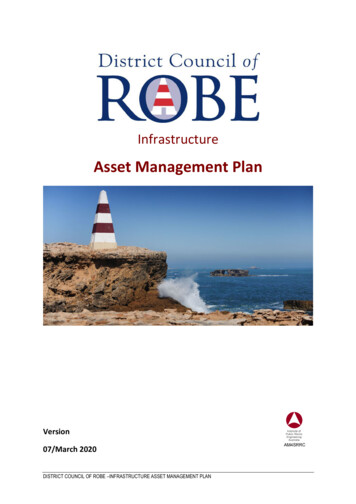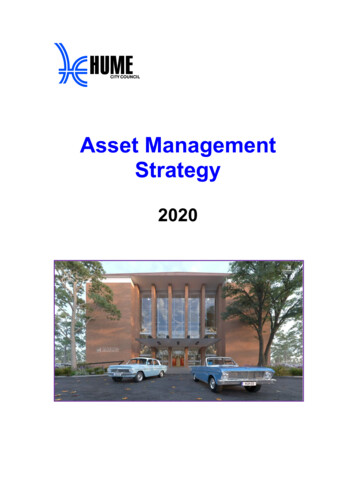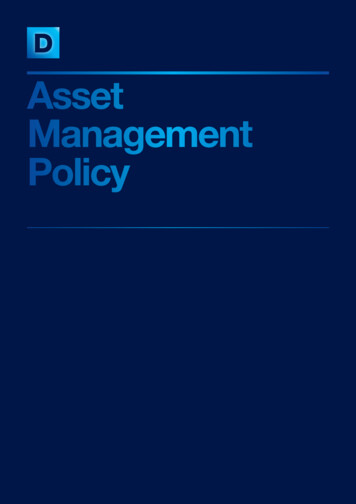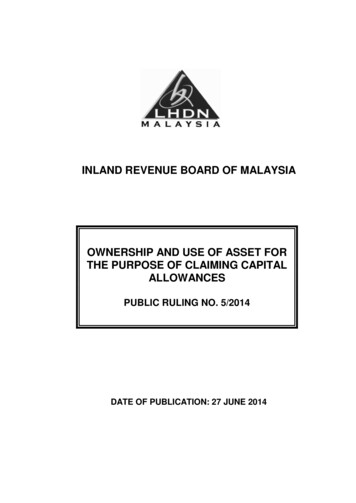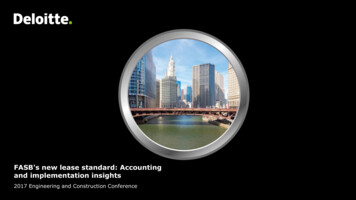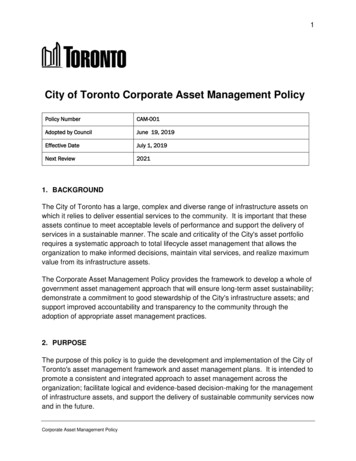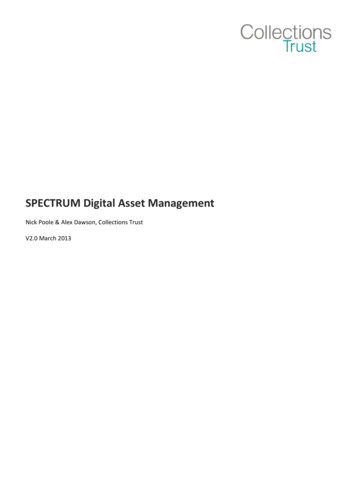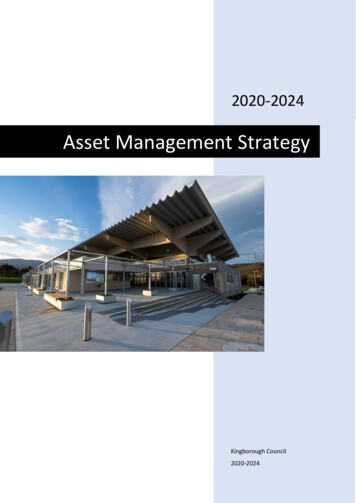
Transcription
2020-2024Asset Management StrategyKingborough Council2020-2024
Contents1Executive Summary. 22Introduction . 434562.1Background . 42.2Purpose and Objective . 42.3Asset Management Systems and Planning Process . 4Assets and Their Management . 73.1Infrastructure Assets . 73.2State of the Assets . 73.3Asset Management Structure. 103.4Corporate Asset Management Team . 103.5Financial and Asset Management Core Competencies. 10Where Do We Want to Be? . 134.1Council’s Vision, Purpose, Values and Goals and Objectives . 134.2Asset Management Policy . 154.3Asset Management Vision . 15How Will We Get There? . 175.1Asset Management Strategies . 175.2Asset Management Improvement Plan . 185.3Monitoring Progress . 20Summary. 21
1 Executive SummaryThis Asset Management Strategy has been prepared to enable Kingborough Council (KC) toimprove the way it delivers services from infrastructure assets 1 including transport, buildings,stormwater and open space assets. These infrastructure assets have a replacement value of 726M.The Asset Consumption Ratio 2 for Council’s infrastructure assets is predominately in therange of 51% to 80% which places them in the stable phase of their life cycle. In this phase,the majority of assets are in the early to middle portion of their life and the demand andurgency on funding i.e. capital renewal expenditure is lower relative to the later life phases.On the lower end of the Asset Consumption ratio are the transport assets and as this assetclass is the largest, particular strategies are needed to avoid these assets degrading furtherover the next few years and moving into the action phase.It is in the action phase where the majority of assets transition from the middle period of theirlife cycle to their penultimate phase. This means the requirement for asset renewalexpenditure will grow at a significantly faster rate than historical levels. The cost of repairs isfour to five times the cost in the stable phase and this inherently leads to an increased risk offuture backlogs 3. Every 10% of our assets that progressively slip into the action phasepotentially pose a high likelihood risk of needing immediate replacement to the tune of 10%of the replacement value. This figure is 72 million out of a circa 726 million. This is ourchallenge and our motivation to embrace this strategy.Moving forward, the challenge for Council is continuing to deliver expected quality services tothe community from its ageing and increasingly more costly infrastructure while making thebest use of its financial resources. To meet this challenge, Council has embarked on acontinuous improvement journey to build on its asset management competencies andcapabilities so that it becomes a ‘Better Practice’ organisation shifting from an ‘Asset CentricFocus’ to a ‘Service Centric Focus’. The action plans in the strategy are aligned to achievethese competencies.The Asset Management Strategy is to enable Council to show 4: 1How its asset portfolio will meet the service delivery needs of its community into thefuture;Not including non-infrastructure assets such as information, communication and technology assets, fleet, plant, and equipment.2 The current life left in our assets based on a condition-based assessment approach3 Using Asset Genetics to Unlock Hidden Capital –McKinsey Global Infrastructure Initiative4LGPMC, 2009, Framework 2 Asset Planning and Management, p 4.
Enable Council’s asset management policies to be achieved; Ensure the integration of Council’s asset management with its long term strategicplans.This Asset Management Strategy will assist Council in meeting the requirements of nationalsustainability frameworks, State legislative requirements and provision of services needed bythe community in a financially sustainable manner.The Asset Management Strategy is prepared following a review of Council’s service deliverypractices, asset management planning and fits with Council’s vision for the future outlined inthe Kingborough Council Strategic Plan 2020-2025. The strategy outlines an assetmanagement improvement plan detailing a program of tasks to be completed and resourcesrequired for Council to maintain a ‘core’ level of asset maturity and competence.Strategy Outlook:1. The process of formulating an updated Long Term Financial Plan (LTFP) informed byCouncil’s Asset Management Plans (AMPs) for transport, buildings, stormwater and openspace assets will follow from the adoption of this strategy.2. The ability of Council to fund current infrastructure life cycle costs at current levels ofservice and available revenue will be determined within the LTFP. The projectedinfrastructure life cycle cost over the next 10 years will be determined within Council’sAsset Management Plans.3. Council’s current asset management maturity is within the ‘core’ level with on-goinginvestment required to improve information management, lifecycle management, servicemanagement and asset management systems. It is anticipated that the majority of thisinvestment will be staff time and centred on the activities of the Engineering Services area.The identified improvement items form a roadmap for improvement over the next four years,to evolve into an organisation that is practising service driven optimisation wholly is detailedin section 5.2.
2 Introduction2.1 BackgroundKingborough Council is one of the fastest growing municipalities in Tasmania, offering urbanand rural lifestyles. It is located 10km south of Hobart and is known for its extensive stretchesof coastline (over 330km). It covers a total area of 717 square kilometres with a populationof 37,000.The main towns are Taroona, Kingston, Blackmans Bay, Margate, Snug, Kettering, Woodbridgeand Middleton. The Municipality also includes Bruny Island which lies just off the coast andcan be reached by vehicular ferry from Kettering. Kingston is the major commercial, retail andadministrative centre for the Municipality. Local industries include fish processing,aquaculture, tourism, viticulture, boat building, civil engineering as well as the Australianheadquarters for Antarctic Research, the Antarctic Division. Kingborough is essentiallyresidential in nature and has one of the highest growth rates in the State. The rate ofpopulation growth in the last five years was 5.8%, or 1.2% per annum. The localities with thegreatest population growth rates are Kingston, Blackmans Bay, Margate and Snug. By 2022,Kingborough’s population is likely to be about 41,000.Kingborough Council is the custodian of an extensive range of community assets that delivera range of Council services. In order to deliver these services over the long term in a rapidgrowth environment, Council must ensure that the assets supporting these services aremanaged in a sustainable way. This Asset Management Strategy along with Council’s AssetManagement Policy and Asset Management Plans for transport, buildings, stormwater andopen space assets form the basis of developing a framework for sustainable service delivery.2.2 Purpose and ObjectiveThe purpose of this Asset Management Strategy is to define and document the necessaryapproaches to be undertaken to achieve the implementation of Council’s Asset ManagementPolicy. The Strategy’s objective is to establish a framework to guide the planning,construction, maintenance and operation of the infrastructure essential for Council to provideservices to the community.2.3 Asset Management Systems and Planning ProcessAsset management planning is a comprehensive process to ensure that assets are managedand maintained in a way that enables affordable services to be provided in an economicallyoptimal way. In turn, affordable service levels can only be determined by assessing Council’sfinancial sustainability under scenarios with varying service levels. Asset management
planning is integrally linked with formulating an informed LTFP. These links are iterative withthe forecast asset expenditure costs from Asset Management Plans (AM Plans) fed into theLTFP. If the required expenditure cannot be met by available income, then service levels fromAM Plans are formulated and reviewed to allow a sustainable LTFP.Asset management planning commences with defining stakeholder and legislativerequirements and needs, incorporating these needs into the organisation’s strategic plan,developing an Asset Management Policy, Asset Management Strategy, Asset ManagementPlans and operational plans and linking these to the LTFP.The asset management planning process and its relationship to organisational Councilprocesses is shown in Figure 1 below.Strategic Plan/VisionAsset Management PolicySets organisational valuesand goals Sets Asset Managementdirection to meetorganisation goalsAsset ManagementStrategy Provides a State ofAssets Provides how AssetManagement directionswill be met Has a program ofongoing improvmentsAsset Management Plans Detailed information oneach asset class Describes level ofservice sought Provides State of Assetsfor each class Provides specificimprovement actionsLong TermFinancial Plan Encapsulates 10 yearfinancial snapshot Based on service leveldemandFigure 1 – Asset Management Planning ProcessAn asset management system is a set of interrelated and interacting elements of anorganisation to establish the asset management policy and asset management objectivesand the processes needed to achieve those objectives. An asset management system is morethan ‘management information system’ software. The asset management system provides ameans for: Coordinating contributions from and interactions between functional units within anorganisation 5; 5Consistent application of the asset management processes to achieve uniform outcomesand objectives.ISO, 2014, ISO 55000, Sec 2.5.1, p 5
The asset management system includes: The Asset Management Policy; The Asset Management Objectives; The Strategic Asset Management Plan (or Asset Management Strategy ); The Asset Management Plans, which are implemented ino operational planning and controlo supporting activitieso control activitieso other relevant processes. 6The Local Government and Planning Ministers’ Council Framework 2 - Asset Planning andManagement (May 2007), seeks to develop a nationally consistent asset managementframework to support improvement in local governments’ asset management performanceand sustainability.The framework aims to assist in highlighting key management issues, promote prudent,transparent and accountable management of local government assets and introduce astrategic approach to meet current and emerging challenges. As part of the framework, thisAsset Management Strategy enables Council to: Meet the objectives set out in its Strategic Plan; Satisfy the service delivery needs of its community into the future; Comply with its Infrastructure Asset Management Policy; Integrate asset management with its LTFP.6ISO, 2014, ISO 55002, Sec 4.1.1, p 2.
3 Assets and their Management3.1 Infrastructure AssetsCouncil infrastructure assets which are outlined in Table 1 below provide a wide range ofservices throughout the municipality.Asset GroupAsset CategoryMeasureTransportCar Parks87,844 (Area sq m)Kerb276 (Length km)Pathways359 (Length km)Roads-Sealed288(Length km)Roads-Unsealed262(Length km)Bridges & Jetties199 (Count)Traffic Management DevicesBuilding235 (Count)BuildingsOpen Space102 (Count)Play Equipment153(Count)Active Recreation, Structures302 (Count)Stormwater Drains322(Length km)Stormwater Gross Pollutant Traps (GPTs)10(Count)Stormwater Pits15740Flow and rain guages5StormwaterTable 1 – Assets covered by this strategy as at 30th June 20203.2 State of the AssetsThe financial status of Council’s infrastructure assets as at 30 June 2020 is shown in Table reciationWritten DownValueTransport 525,568,794 6,969,890 256,344,775 269,224,019Building 66,207,618 1,172,871 25,191,767 41,015,851Open Space 18,275,296 455,896 3,978,350 14,296,946Stormwater 116,792,518 1,142,960 32,861,302 83,931,216Grand Total 726,844,226 9,741,617 318,376,194 408,468,032Asset ClassTable 2 – Financial status of assets as at 30 June 2020Figure 2 below provides the asset class asset split by replacement value:
INFRASTRUCTURE ASSET CLASS16%3%9%72%TransportBuildingOpen SpaceStormwaterFigure 2 – Asset Replacement Values as % of Total ValueThe asset consumption ratios of Council’s assets (i.e. the average proportion of ‘as new’condition remaining in assets in accord with financial valuations) are shown in Figure 3.STATE OF ASSETSState of assets90%78%Remaining service ildingsOpen SpaceStormwaterFigure 3 – Asset Consumption Ratio - % ‘As New’ RemainingThe asset consumption ratios of Council’s assets as shown in these figures show that thetransport assets are by far Council’s largest asset class comprising over 72% of total assetvalue and that assets have been the most heavily consumed with an overall average of 51%
remaining by value. This higher level of consumption puts this class onto the cusp of asustained action phase for the network and has come about by two main factors: Componetisation of transport assets and recognition of previously unaccounted forassets has changed the understanding of life cycle phase of the overall class. A general under investment in the class has caused gradual deterioration of thenetwork over a period of time.This has been recognised and is starting to be addressed by gradually increasing expenditureon renewing transport assets. This increase in funding commenced 5 years ago and isallowing in particular more replacement of road seals and renewal of major unsealed roads.A recent condition assessment of the sealed road part of the Transport asset class hasidentified that this strategy has had some traction and this is expected to be reflected with animproved consumption ratio at the next asset class revaluation in 2021/22.This is reflected in Figure 4 below that shows the Asset Sustainability ratio (proportion ofrenewal works being spent on assets relative to the annual depreciation) over the last 5 yearsbeing highest for Transport and Stormwater assets classes. In particular this relates mainlyto the following: Increased expenditure for resealing of sealed roads with over triple the budget beingallocated over previous historical budgets.The setting of a stormwater levy which has allowed funding for undercapacity and poorcondition infrastructure.More detailed information is held within the individual asset management plans for each assetclass and is supported by various condition assessments and anyalsis of networks. FUNDING OF ASSETS80706050403020100TransportBuildingsOpen SpaceStormwater5 year averageFigure 4 – Asset Sustainability Ratio – average 5-year renewal spend versus depreciation.
3.3 Asset Management StructureThe organisational structure of Council places infrastructure assets in the Engineeringdivision under the Executive Manager of Engineering Services. Within the division lies theAsset Management section which perform all the asset management related functions.Closely related and supporting this area are Council’s GIS unit and Finance area.In 2018 Council undertook a redevelopment of the long-term Asset Management Plan and thiswill be due for review in 2020 to support and complement this Asset Strategy and the AssetPolicy. These items are considered as foundational in ensuring Council fast growth is wellplanned and managed and Council’s physical assets are well maintained and in turn enablingthe development of an informed LTFP.3.4 Corporate Asset Management TeamA ‘whole of organisation’ approach to asset management may be best developed with acorporate asset management team. The benefits of a corporate asset management teaminclude: Demonstrating corporate support for sustainable asset management; Encouraging corporate buy-in and responsibility; Coordinating strategic planning, information technology and asset management activities; Promoting uniform asset management practices across the organisation; Pooling of corporate expertise; Championing of asset management process; Wider accountability for achieving and reviewing sustainable asset managementpractices.Council has an established Asset Management Group, compromising members of the assetteam and finance team, however it may be there is better value in having a more representativecouncil wide group to ensure that projects and initiatives meet Council’s strategic objectives.3.5 Financial and Asset Management Core CompetenciesThe National Frameworks on Asset Planning and Management and Financial Planning andReporting define ten elements for asset management. Eleven core competencies have beendeveloped from these ten elements 7 to assess ‘core’ competency under the NationalAssessment Framework. The core competencies and corresponding core questions are:7Asset Planning and Management Element 2 Asset Management Strategy and Plans divided into Asset Management Strategy and AssetManagement Plans competencies.
Financial Planning and Reporting:1. Strategic Longer-Term Plan – Does Council have an adopted strategic longer-term plan?2. Annual Budget – Does Council prepare an annual budget?3. Annual Report – Does Council publish an annual report?Asset Planning and Management:4. Asset Management Policy – Does Council have an adopted Asset Management Policy?5. Asset Management Strategy – Does Council have an adopted Asset ManagementStrategy?6. Asset Management Plan – Does Council have adopted Asset Management Plans?7. Governance & Management – Does Council have good management practices linkingasset management to service delivery?8. Levels of Service – Does Council have a defined process for determining current andtarget levels of service and costs?9. Data and Systems – Does Council have the data and systems to perform assetmanagement activities?10. Skills and Processes – Does Council have the data & systems knowledge to perform assetdata management activities?11. Evaluation – Does Council have a process to evaluate progress and use of resources onthe implementation of the National Frameworks?As part of the NAMS.PLUS 3 system the Institute of Public Works Engineering Australia(IPWEA) has developed maturity assessment models to assist Councils to assess their assetmanagement maturity and capability. The maturity assessments are based on the AustralianNational Asset Management Assessment Framework (NAMAF) and the international assetmanagement Standard, ISO 55001 Asset Management – Management Systems –Requirements.To determine where Council is on its strategic asset management journey, a reference to theNAMAF scorecard is made. The NAMAF scorecard is illustrated in Figure 5. Each category isscored against a set list of criteria that seek to audit Council AM knowledge and functions.Collectively, these criteria assess an organisation’s advanced asset managementcompetency. Each criterion is assessed with multiple questions aimed at identifying whereCouncil is on its journey to better practice asset management. While a score of 100% indicatesthat better practice has been achieved in a particular assessment criteria, a score of 80%indicates that good practice asset management standard has been achieved. It is generallyaccepted that the organisational target should be to achieve a good practice assetmanagement standard across all categories before aiming higher.
Overall, Council is well placed on its Strategic Asset Management journey. The areas requiringthe greatest level of improvement are those involving the capacity and functionalityassessment of Council’s infrastructure assets which are characteristics of advanced assetmanagement maturity and a service-oriented framework to manage assets.If these areas of assessment are set aside, the assessment shows that Council is operatingwith most of the criteria at “better practice” and some at “good practice” for Core AssetManagement Competency.Asset Management MaturityResource levelsStaff skillsSystem and toolsAsset AccountingMaintenance planningCapital works planning and budgetingAsset inspections-Risk and maintenanceAsset functionality assessementService capacity assessmentCondition assessment(collection process)Condition assessment(practice)Asset Data (Compenentisation)Asset Data(Holistic List)Levels of service (Documenation)Levels of service (Awareness)Plans and Strategy (application)Plans and Strategy (status)Governance and CommitmentNational Guideline Awareness0%Current Assessment10% 20% 30% 40% 50% 60% 70% 80% 90% 100%Best Practice GapExcellence GapFigure 5 – Asset Management MaturitySpecific actions to allow Council to obtain a full “better practice” with core targets aredocumented in Table 5. These actions are listed as improvement items as an output of thisstrategy and will be driven through Council’s Asset Management area.
4 Where Do We Want to Be?4.1 Council’s Vision, Purpose, Values and Goals and ObjectivesThis Asset Management Strategy is prepared in accord with Council’s vision, purpose, valuesand strategic objectives: Council’s vision is“Our community is at the heart of everything we do” Council’s purpose is:“To make Kingborough a great place to live” Council’s values are:“Accountability, respect, excellence and inclusiveness”
Relevant Council goals and objectives and how these are addressed in this AssetManagement Strategy are detailed in Table 3 below:Strategic GoalStrategic OutcomeObjectiveDeliver qualityinfrastructureand servicesService provision meets thecurrent and futurerequirements of residentsand visitorsUnderstand current and future service needs and be ready toadjust as community needs change.Infrastructuredevelopment and servicedelivery are underpinnedby strategic planning tocater for the needs of agrowing populationCommunity facilities aresafe, accessible and meetcontemporary standards.Identify and plan for addressing gaps in communityinfrastructure that will hinder service provision.Leverage technology to provide best value asset/serviceprovisionEnsure long term financial plans and asset management plansare in place and are robust to cater for changing needs.Develop stakeholder engagement processes to be aware ofcommunity needs and to underpin key delivery performanceindicators.Provision of and access to services, and amenities.Promote active transport options in the road and open spacenetwork.Ensure infrastructure is adequate, safe and contributes to thewellbeing of the community.Support creation of a connected and active communitythrough the design and delivery of walking and cyclingnetworks.Ensure facilities are designed and built to accommodategrowth, diverse needs and future flexibility.Provision of spaces and places for the community to meet,reflect and ‘just be’.Undertake integrated open space planning to ensure newneighbourhoods have timely access to reserves, parks,gardens, heritage places and natural assets.Sustaining for the futureCouncil is able todemonstrate strongenvironmental stewardshipand leadershipEnsure sustainable asset practices are used includingconsidering the use of recycled materialsTable 3 - Council’s Strategic Objectives
4.2 Asset Management PolicyCouncil’s Asset Management Policy was adopted in September 2016 with the next review dateto occur in September 2020. The Asset Management Policy defines Council’s vision andservice delivery objectives for asset management.The Asset Management Strategy is developed to support the Asset Management Policy andto enable Council to show: How its assets will meet the affordable service delivery needs of the community into thefuture; Enable Council’s Asset Management Policy to be achieved; Ensure the integration of Council’s asset management with its long-term strategic plans,including the LTFP.Figure 6 – Key Elements of Asset Management Planning Strategy4.3 Asset Management VisionTo ensure the long-term financial sustainability of Council, it is essential to balance thecommunity’s expectations for services with their ability to pay for the infrastructure assetsused to provide the services. Maintenance of service levels for infrastructure services requiresappropriate investment over the whole of the asset life cycle. To assist in achieving thisbalance, Council plans:To ensure that infrastructure assets support services that are appropriate, accessible,responsive, timely and sustainable to the community, in accordance with responsible asset
management that will preserve the life of the asset and ensure that the community isreceiving the best value for money.In line with this vision, the objectives of the Asset Management Strategy are to: Ensure that Council’s infrastructure services are provided in an economically optimal way,with the appropriate level of service to residents, visitors and the environment determinedby reference to Council’s financial sustainability; Safeguard Council’s assets including physical assets and employees by implementingappropriate asset management strategies and providing appropriate financial resourcesfor those assets; Identify where decision making and investment choices can be enhanced by using smarttechnology options; Support the use of environmentally sustainable approaches to asset provision; Adopt the LTFP as the basis for all service and budget funding decisions; Meet legislative requirements for all Council’s operations; Ensure resources and operational capabilities are identified and responsibility for assetmanagement is allocated; Ensure high level oversight of financial and asset management responsibilities arereported to Council with regards to the development and implementation of the AssetManagement Strategy, Asset Management Plans and Long-Term Financial Plan.Strategies to achieve this position are outlined in Section 5.
5 How Will We Get There?5.1 Asset Management StrategiesThe Asset Management Strategy proposes strategies to enable the objectives of the StrategicPlan, and Asset Management Policy to be achieved. These strategies are outlined in Table 4below.No12StrategyAnnually review and update Asset ManagementDesired OutcomeIdentification of services needed by thePlans covering at least 10 years for all major assetcommunity and required funding toclasses.optimise ‘whole of life’ costs.Develop a 10-year LTFP incorporating assetSustainable funding model to providemanagement plan expenditure projections with aCouncil services.sustainable funding position outcome.3Ensure Council’s decisions are made from accurateImproved decision making and greaterand current information in asset registers, onvalue for money.service level performance, costs and ’whole of life’costs.4Ensure responsibilities for asset management areResponsibility for asset managementidentified and incorporated into staff positionis defined.descriptions.5Implement Improvement Plan actions.Improved asset management capacitywithin Council.67Identify and where appropriate implement newTechnology as a tool is consideredtechnology options to provide improved value forformally in asset managementmoney services.decision making.Consider where recycled product and/or servicesActive way of reducing Council’sthat provide a better outcome for the environmentenviromental footprint.can be implemented in asset provision8Move from annual budgeting to LTFP across allThe long term implications of Councilasset classes.services are considered in annualbudget deliberations.9Report yearly to Council’s Audit Committee onOversight of resource allocation anddevelopment and implementation of Assetperformance.Management Strategy, AM Plans and LTFP.10Report on Council’s resources and operationalService delivery is matched to availablecapability to deliver the services needed by theresources and operational capabilities.community in the Annual Report.11Review and update Asset Management Plans andCouncil and the community are awareLTFP after the adoption of annual budgets.of changes to service levels and costsCommunicate any consequence of
An asset management system is a set of interrelated and interacting elements of an organisation to establish the asset management policy and asset management objectives and the processes needed to achieve those objectives. An asset management system is mor e than 'management information system' software. The asset management system provides a
